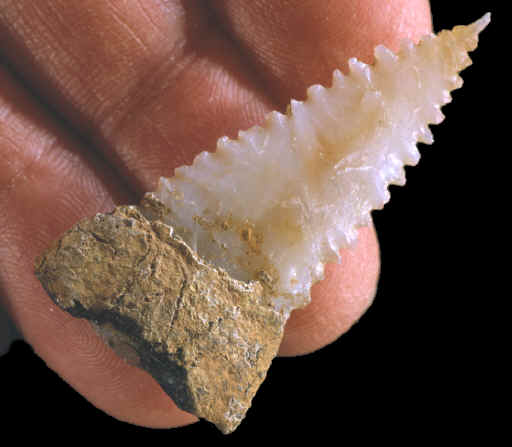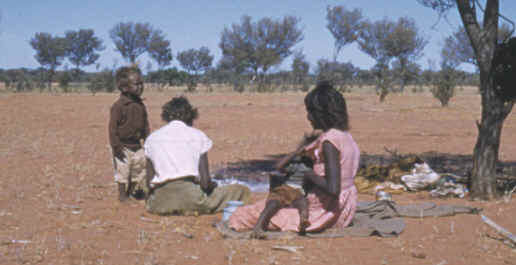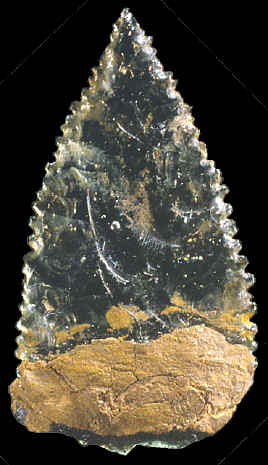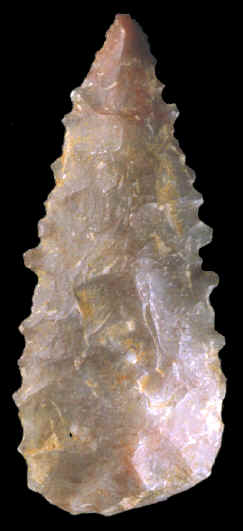|
|
|
Spears tipped with Kimberley points were thrown through the air with a spear-thrower called a womera. A womera is a multi-purpose tool that could be used for several different functions. It could be used to propel spears through the air, the curved wooden handle could serve as a small dish, it could be used as a fire making tool by rapidly rubbing the edge across another piece of wood and it could be used as a cutting tool when a stone adze was hafted on the end of the handle. |
|
|
|
|
Prior to the use of Kimberley points in Australia, a variety of fairly well flaked spear points appear in the archaeological record between 5,000 and 6,000 years ago. One of the terms that has been used to describe some of these points is Pirri. Pirri points and other varieties are generally leaf shaped. None of them were notched. They were made on blades (flakes) that were struck off cores with a hammer stone. Pirri points are mostly unifacial points (flaked on one side only) and they begin to disappear about 2,500 years ago. They were succeeded in the northern and central regions by yet another type of stone spear point. However, none of these points were made with the skillful pressure flaking that the more recent Kimberley points are famous for. |
|
|
|
|
Kimberley points stand out in Australia's long history of stone tool making as the most skillfully made and artistically designed projectile point. It is still unclear where the pressure flaking technology that made them originated. This technology either came in from another area or was separately invented, away from an outside influence, in northwestern Australia. A missionary named J.R.B. Love described the manufacturing process of a Kimberley point as follows: "For an anvil he uses a slab of sandstone, on which he places "a cushion" consisting of several layers of paper-bark. With a blunt-pointed stick of hard wood, a foot in length, he presses on one edge of the small stone he has produced from his wallet and placed on the anvil, and breaks off a flake. Turning the stone, he continues this till he has roughed out the shape of a spear-head. He next takes a piece of a kangaroo's thigh bone, ground to a point on a rough stone, and presses flakes away from the edges of the spear-head, till he has reached the finished shape. The final stage is now to take a thin bone, ground to a fine edge, and serrate the edges of the spear-head by pressing out the tiny flakes form the sharp edges. This is a very delicate operation and a careless pressure will break a spear-head that has taken much labor to bring to the desired shape. The whole work of making stone spear-heads is a highly skilled art. Some of the stones used are semi-precious, as agates and crystals. The completed spear-head is a really beautiful object, with needle point and wonderfully symmetrical edges." |
|
|
|
|
Kimberley points were made from a variety of different cherts, chalcedony, quartzite, crystal and glass. Some of the materials are reported to have been heat-treated to make the stone easier to flake. The Worora tribe, in the northwest Kimberley region, used colorful materials of good quality to make their Kimberley points. They were using translucent orange, red, yellow and white chalcedony, fine grained quartzite that is similar to Hixton from Wisconsin and Spanish Diggings from Wyoming and even quartz crystal and milky quartz. They were also using a variety of other cherts. After European contact they began to use glass from bottles and telegraph insulators. |
|
| CONTINUE ON TO PAGE THREE | |
|
"REFERENCES"
1949,
Mitchell, S.R., "Stone-Age Craftsmen, Stone Tools & Camping
Places of the Australian Aborigines" pp. 62-64. |
|



